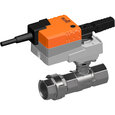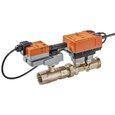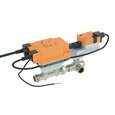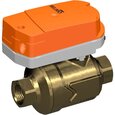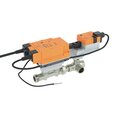HVAC Valves - Pressure Dependent vs Pressure Independent
Figure 1: Belimo pressure independent control valve with actuator
Understanding the differences between pressure dependent and pressure independent valves is key to optimizing HVAC system performance. Pressure-dependent valves are cost-effective but can be sensitive to system pressure variations, requiring regular balancing to maintain efficiency. In contrast, pressure-independent valves offer consistent flow control, adapting to pressure changes and reducing the need for frequent adjustments. This article examines the operational benefits and potential energy savings of each valve type within HVAC applications.
Table of contents
- Pressure dependent control valves
- Pressure independent control valves (PICVs)
- Pressure dependent vs pressure independent valves
- Conclusion
- FAQs
View our online selection of HVAC valves!
Pressure dependent control valves
Pressure-dependent valves, like globe, ball, and butterfly valves, modulate water flow based on the pressure differential across the valve. These pressure-controlled valves are simpler and typically less expensive, but their performance is directly affected by system pressure changes. As a result, they can cause an imbalance in an HVAC system, leading to areas with too much or too little flow, inefficient operation, and discomfort for occupants. These valves require careful balancing during installation and may need periodic rebalancing to maintain proper system operation. Balancing is the initial adjustment of an HVAC system to ensure the even distribution of air or water flow according to design specifications. Rebalancing is readjusting the system over time to maintain proper flow distribution as changes occur within the system or building usage. Read our central heating article for more information on how a central heating system works and how to create zones to optimize energy efficiency.
Figure 2: HVAC ball valve
Pressure independent control valves (PICVs)
PICVs are designed to deliver a constant flow rate regardless of pressure fluctuations within the system. They achieve this through an internal mechanism that adjusts the valve opening to compensate for pressure changes, ensuring stable and precise flow. This simplifies the balancing process and reduces the need for additional balancing valves, leading to improved performance, energy savings, and reduced installation costs.
Design and functionality
PICVs are integrated units that combine multiple valves, like the control valve and a pressure regulator, streamlining design and installation while enhancing system efficiency. They consist of a main body with an inlet and outlet, and some models feature ports with color-coded ports for manual pressure readings (Figure 1). The top section of a PICV houses the control valve for setting the flow rate, which can be adjusted manually or through an actuator. The bottom section contains the differential pressure controller, compensating for pressure changes to maintain a stable flow rate.
Mechanism of pressure independence
The PICV includes a differential pressure regulating valve that controls flow through a diaphragm that moves in response to pressure changes. This regulator maintains a constant flow regardless of pressure fluctuations, absorbing all pressure changes and holding the differential pressure constant over the control valve section.
Applications and benefits
PICVs are used in various settings, such as offices, hotels, hospitals, and schools, and are especially beneficial in heating and cooling systems. They are ideal for variable flow systems with secondary side variable speed pumps and are also effective as flow limiters in constant flow systems.
-
Energy savings:
- PICVs automatically adjust to maintain a constant flow to each terminal unit (like a fan coil or air handling unit), even when system pressure changes. This prevents excess water from flowing through the system, which would otherwise require more pumping energy and lead to inefficiencies.
- PICVs help maintain an optimal ΔT by ensuring that the correct amount of water flows through the system, allowing for efficient heat exchange and reducing the need for the chiller to work harder than necessary. Delta T (ΔT) refers to the temperature difference between the supply and return water in a chilled water system. A low ΔT indicates that the return water is not much cooler than the supply water, suggesting that the system is not effectively removing heat from the space.
- System performance and maintenance: PICVs ensure that HVAC systems operate at full potential, with each valve preset with a specific flow setting that can be adjusted. This pre-calibration allows the system to perform optimally from startup, and the flow control of existing circuits remains intact even with system expansions, eliminating the need for rebalancing.
- Dynamic balancing and zero leakage: PICVs provide precise flow control, dynamically balancing the load under all conditions and preventing energy loss through features like zero leakage. This guarantees reliable valve operation and is crucial for maintaining building performance and long-term energy efficiency.
Types
Mechanical
The mechanical PICV automatically compensates for pressure fluctuations to maintain a constant flow rate without needing electronic sensors or feedback. They typically have an adjustable flow cartridge that can be set manually to the desired flow rate. They are simpler in design and do not require power for the flow control element, although they may have an actuator that requires power for valve position control. Mechanical PICVs are often less expensive and easier to maintain due to the lack of electronic components for flow measurement.
Figure 3: Belimo mechanical PICV
Electronic (ePICV)
The ePICV integrates a flow meter and a 2-way control valve. Electronic PICVs incorporate electronic components, such as ultrasonic flow sensors, to accurately measure and control the flow rate. They provide electronic feedback, which can be integrated into building management systems for more precise control and monitoring. Electronic PICVs are more complex and may have higher initial costs, but they offer greater functionality and control options.
Figure 4: Belimo electronic PICV
Energy valve
The energy valve measures and manages coil energy using an embedded flow meter and temperature sensors. The valve communicates with building management systems (BMS) via BACnet MS/TP or BACnet IP and has a built-in web server for data collection. Read our HVAC energy efficiency article for more details on energy optimization techniques for an HVAC system.
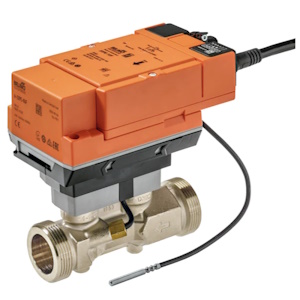
Figure 5: HVAC energy meter
Pressure dependent vs pressure independent valves
Selecting the right valve type depends on balancing initial costs against efficiency, maintenance, and long-term operational savings.
-
Cost
- Pressure-dependent valves: Lower initial cost but potentially higher long-term expenses due to increased energy and maintenance needs.
- Pressure-independent valves: Higher initial cost, balanced by long-term savings from reduced energy use and maintenance.
-
System efficiency
- Pressure-dependent valves: Efficiency varies with system pressure changes, possibly causing uneven heating/cooling.
- Pressure-independent valves: Consistent flow rates ensure stable system performance and efficiency.
-
Maintenance and balancing requirements
- Pressure-dependent valves: Need for initial and periodic rebalancing, increasing maintenance efforts.
- Pressure-independent valves: Self-balancing reduces maintenance and simplifies operation.
-
Energy consumption
- Pressure-dependent valves: Risk of higher energy consumption due to imbalances and over-pumping.
- Pressure-independent valves: Automatic flow adjustments lead to energy savings and reduced operational costs.
-
Suitability for different HVAC systems
- Pressure-dependent valves: Best for smaller, stable systems where cost is a major concern.
- Pressure-independent valves: Ideal for complex, variable systems requiring consistent comfort and efficiency.
Conclusion
When comparing pressure-dependent and independent control valves, it's important to consider long-term operational costs and energy savings. While pressure dependent valves may have a lower initial cost, they can lead to higher energy consumption and maintenance expenses. Pressure-independent valves, though potentially more expensive up front, can offer significant savings due to their self-balancing nature and improved system performance.
FAQs
What is the advantage of PICV?
PICV (Pressure Independent Control Valve) ensures consistent flow regardless of pressure fluctuations, improving system efficiency and reducing energy consumption.
What is the difference between PICV and PIBCV?
PICV regulates flow and maintains balance regardless of pressure changes. PIBCV (pressure independent balancing and control valve) does the same but also controls temperature.





